免疫进化算法
免疫算法的七个要素

免疫算法的七个要素
免疫算法的七个要素包括:
1. 识别抗体:把目标函数和约束作为抗体。
2. 生成初始化的抗体:随机生成独特型串维数为M的N个抗体。
3. 计算亲和度:这个步骤是免疫算法的重点,也是最难点。
4. 记忆细胞分化:同人的免疫系统基本一致,与抗原有最大亲和度的抗体加入了记忆细胞。
由于记忆细胞数目有限,因此新生成的抗体将会代替记忆细胞中和它有最大亲和力者。
5. 抗体促进和抑制:通过计算抗体v的期望值,消除那些低期望值的抗体。
6. 产生新的抗体:基于不同抗体和抗原亲和力的高低,使用轮盘赌的方法选择两个抗体。
然后把这两个抗体按一定变异概率做变异,之后再做交叉,得到新的抗体。
重复操作直到产生所有N个新抗体。
可以说免疫算法产生新
的抗体的过程需要遗传算子的辅助。
7. 结束条件:如果求出的最优解满足一定的结束条件,则结束算法。
以上是免疫算法的七个要素,建议查阅关于免疫算法的资料以获取更多信息。
基于免疫进化的粒子群混洗蛙跳算法
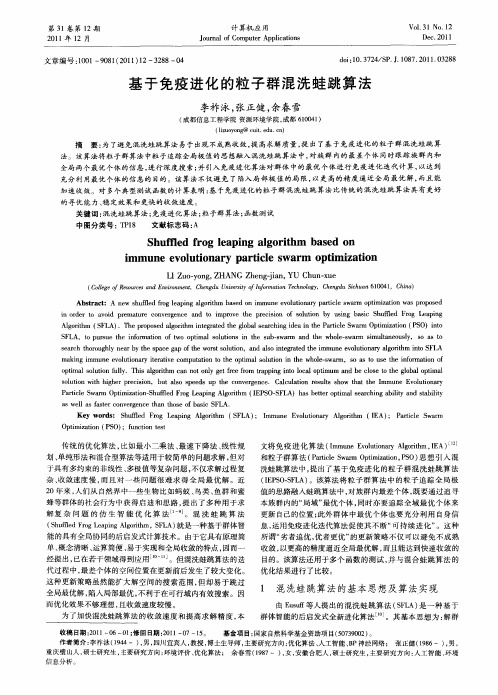
21 年 1ቤተ መጻሕፍቲ ባይዱ 01 2月
计 算 机 应 用
Jun l fC mp trA piain o r a o ue p l t s o c o
V0 . No.1 1 31 2 De . 01 c2 1
文 章 编 号 :0 1 9 8 (0 1 1 10 — 0 1 2 1 )2—3 8 0 2 8— 4
A grh ( F A . h rpsda oi m it rt eg blerhn e ePrc w r pi zt n( S )it l i m S L ) T e o oe grh e a dt l a sacigi ai t a ieS a O t ai P O no ot p l t ng e h o d nh t l m mi o
摘
要 : 了避 免混洗蛙跳 算法易于 出现不成熟收敛 , 高求解质量 , 出了基 于免疫进化 的粒子群混 洗蛙跳 算 为 提 提
法。该算 法将粒子群算 法中粒子 追踪全局极值 的思想融入 混洗蛙跳 算法 中, 对族群 内的最差 个体 同时跟踪 族群 内和 全局 两个最优 个体 的信 息, 行深度搜 索; 进 并引入免 疫进化 算法对群体 中的最优 个体进行免 疫进化迭代 计算 , 以达到 充分利 用最优 个体 的信 息的 目的。该 算法不仅 避免 了陷入局 部极值 的局 限, 以更高的精度 逼近 全局最优 解 , 而且能 加速 收敛。对多个典型测试 函数 的计 算表 明 : 于免疫进化的粒子群混 洗蛙跳 算法比传统的混 洗蛙跳 算法具有更好 基
di1 .7 4 S ..0 72 1. 38 o:0 3 2/ P J18 .0 0 2 8 1
基 于免疫进化 的粒 子群 混洗 蛙跳算 法
第7章 免疫算法

7.1.2 免疫系统的生物学原理
从人的角度:免疫的主要作用是帮助人体自身的 免疫系统抵制由病毒和细菌引起的疾病。 从生物学角度:免疫或免疫接种是强化个体抵御 外部个体的能力的过程。
7.1.2 免疫系统的生物学原理
相关名词
抗原:被免疫系统看作异体,引起免疫反应的分 子。即能刺激人体免疫的细胞,使人体产生免疫 反应的物质。可以是人体本身固有的,如血液, 也可以是人体内根本不存在的,如某些细菌,病 毒,药物等。 抗体:免疫系统用来鉴别和移植外援物质的一种 蛋白质复合体。每种抗体只识别特定的目标抗原。 当某种抗原刺激人体后,人体对这种抗原会产生 一种能识别它,并抵抗或消灭它的物质。当这种 抗原再次入侵时,人体会产生抵抗(免疫)能力, 从而避免疾病的发生。
7.3.1 负选择算法
监视保护数据S
初始串集合S随机变异若 干部分
检测器R
两集合的串存在匹配 否 探测到非自体
是
没有探测到
7.3.2 克隆选择算法
克隆选择原理图
抗原 抗原决定基 抗体决定簇 10011001 11101001 01100110
成熟
2
12
47
128
死亡
骨髓
克隆选择
2
2
2
2
128
128
7.1.2 免疫算法的生物模型
病原体
皮肤 生理学环境
先天性 免疫应答
巨噬细胞
后天性 免疫应答
受体
B淋巴细胞
图 免疫系统层次示意图
7.1.3 二进制模型
轻链 抗体决定簇 Paratope
图 B细胞抗体结构图
抗体j 重链 抗原决定基 Epitope
抗体k B 淋巴细胞
人工免疫思维进化算法的设计
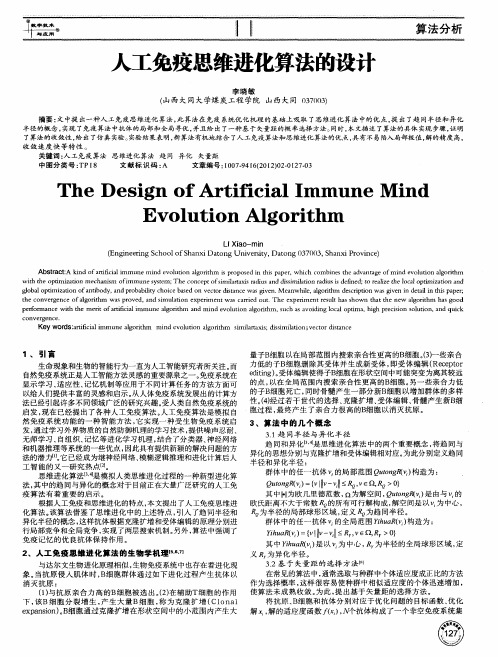
c nv r n e o e ge c ・
Ke y WOr at ca m m u lortm m i v l in ag rt dS:ri ili i f neag ih nde outo lo hm smia a i; si i to ve t itnc i i lr xs dis l i n; cord sa e t m a
w i h t iai e ha im i t teop m z t h i onm c ns ofmm u y tm ; nesse Thec c pt fs i r xsrdu n ismi t n rdu sd f e ;o e l etelc l pt iain nd on e i lt i a isa ddsi l i a isi e n d t rai h a i z t o m aa ao i z o o m o a
p ror a e wih t e m e to ri c a m mun l o t e f m nc t h r fa f ili i ti e ag r hm n nd e o uto l or h ,s h a v i i g l c lo tma hi h p e ii o u i n, nd qu c i a d mi v l i n ag i m uc s a o d n o a p i , g r c s t on s l to a i k
基于免疫进化算法的PID参数整定
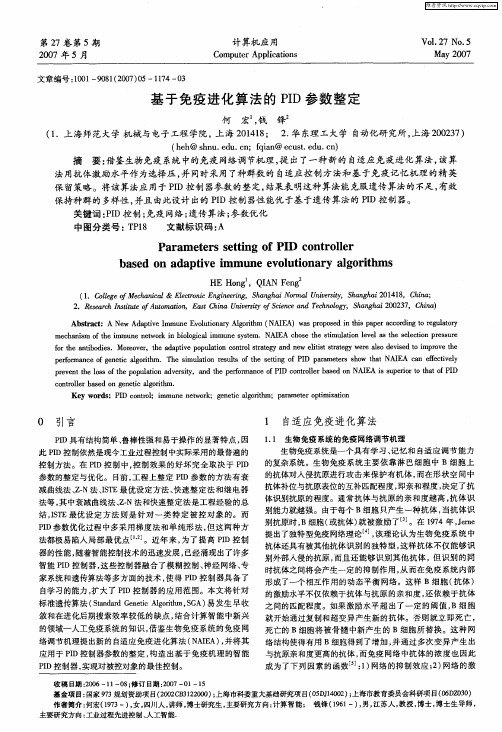
Ke r s I c n r l i y wo d :P D o to; mmu e n t o k e e i lo t m;p r ee p mia c n e r ;g n t ag r h w c i a a t ro t z f - m i in
0 引言
PD具有结构 简单 、 I 鲁棒性强 和易于操作 的显著特 点 , 因 此 PD控制依然 是现今工业过程控制 中实 际采用 的最普 遍的 I 控 制方法 。在 PD控制 中, I 控制效 果 的好坏 完全 取 决于 PD I 参数的整定 与优化 。 目前 , 工程 上整定 PD参 数 的方法有 衰 I 减 曲线法 、 — 、S E最优设 定方法 、 z N法 IT 快速 整定 法 和继 电器 法等 , 中衰减曲线法 、 . 其 z N法和快速整 定法是 工程经验 的总 结, T I E最优设 定 方法 则 是 针对 一 类 特 定 被控 对象 的。而 S PD参数优化过程 中多采用 梯度 法和单 纯形 法 , 这两种 方 I 但 法都极易 陷入局 部最 优 点[2。近年 来 , 了提 高 PD控 制 1 . 3 为 I
维普资讯
第2 7卷 第 5期
多目标的免疫进化算法

多目标的免疫进化算法免疫进化算法(Immune Evolutionary Algorithm,IEA)是一种模拟生物免疫系统的算法,它以免疫机制对生物系统中的非自身物质进行检测和消除为基础,将免疫机理与进化算法相结合,构建出一种新的计算智能算法。
在很多现实问题中,往往会涉及到多个目标的优化,而传统的进化算法只能针对一个目标进行优化,无法同时优化多个目标。
为了解决这一问题,学者们将多目标优化问题引入到免疫进化算法中,形成了多目标免疫进化算法(Multi-objective Immune Evolutionary Algorithm,MOIEA)。
多目标优化问题中存在多个矛盾的目标,而MOIEA的核心思想在于设计一个能够在多个目标之间平衡的适应度函数,通过协同进化的方式来实现多目标优化的目的。
MOIEA的优点在于它能够在同一时间内对多个目标进行寻优,避免了在设计中对单一目标的过度关注。
同时,该算法也弥补了其他多目标优化算法在处理不均衡目标时的缺陷,能够在目标数量不确定或不确定的解决方案存在的情况下进行优化。
在MOIEA算法中,主要有两种策略:一是Dominance Strategy (支配策略),二是Diversity Strategy(多样性策略)。
Dominance Strategy是MOIEA算法中的核心策略,通过将解集中的解根据目标函数值中的支配关系分为不同的支配层,实现对解集内部的排序和选择。
换句话说,Dominance Strategy将所有解分成不同的层级,第i+1层中所有解都被第i层的解所支配。
Diversity Strategy则是用来保证解集的多样性,确保解集中的解对应不同的目标方案。
这种策略可以通过(1)交叉操作、(2)变异操作、(3)聚合策略等方式来达到。
MOIEA算法已被应用于多个领域,包括电力网络规划、城市交通规划、纺织工艺优化、信号处理等,取得了不错的效果。
然而,MOIEA仍然存在一些问题,如处理高维问题时过程变得非常缓慢。
基于免疫进化算法(IEA)的鹤望兰(Strelitzia reginae)叶面积指数(LAI)模拟
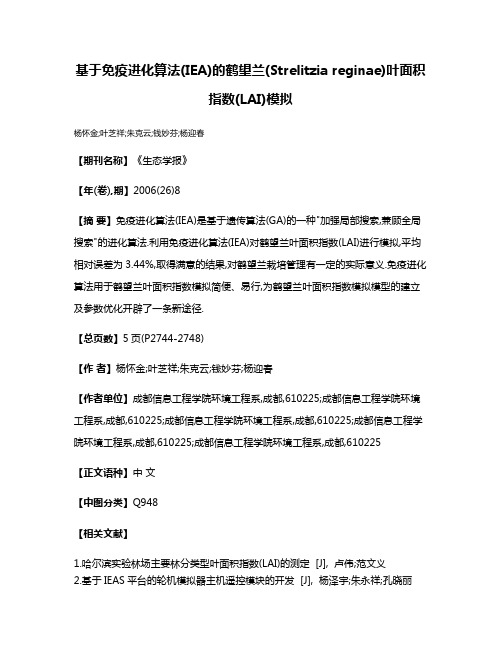
基于免疫进化算法(IEA)的鹤望兰(Strelitzia reginae)叶面积
指数(LAI)模拟
杨怀金;叶芝祥;朱克云;钱妙芬;杨迎春
【期刊名称】《生态学报》
【年(卷),期】2006(26)8
【摘要】免疫进化算法(IEA)是基于遗传算法(GA)的一种"加强局部搜索,兼顾全局搜索"的进化算法.利用免疫进化算法(IEA)对鹤望兰叶面积指数(LAI)进行模拟,平均相对误差为3.44%,取得满意的结果,对鹤望兰栽培管理有一定的实际意义.免疫进化算法用于鹤望兰叶面积指数模拟简便、易行,为鹤望兰叶面积指数模拟模型的建立及参数优化开辟了一条新途径.
【总页数】5页(P2744-2748)
【作者】杨怀金;叶芝祥;朱克云;钱妙芬;杨迎春
【作者单位】成都信息工程学院环境工程系,成都,610225;成都信息工程学院环境工程系,成都,610225;成都信息工程学院环境工程系,成都,610225;成都信息工程学院环境工程系,成都,610225;成都信息工程学院环境工程系,成都,610225
【正文语种】中文
【中图分类】Q948
【相关文献】
1.哈尔滨实验林场主要林分类型叶面积指数(LAI)的测定 [J], 卢伟;范文义
2.基于IEAS平台的轮机模拟器主机遥控模块的开发 [J], 杨泽宇;朱永祥;孔晓丽
3.黑河流域叶面积指数(LAI)空间尺度转换 [J], 张万昌;钟山;胡少英
4.基于叶面积指数(LAI)的小麦变量施氮模型研究 [J], 马新明;张娟娟;席磊;刘合兵;高项飞
5.叶面积指数(LAI)测定方法研究进展 [J], 程武学;潘开志;杨存建
因版权原因,仅展示原文概要,查看原文内容请购买。
免疫算法介绍PPT课件

应用领域
免疫算法在多个领域得到广泛应用,如组 合优化、机器学习、数据挖掘、电力系统、 生产调度等。
研究现状
目前,免疫算法的研究已经取得了一定的 成果,但仍存在一些挑战和问题,如算法 的收敛速度和稳定性等。
研究展望
理论完善
未来研究将进一步完善免疫 算法的理论基础,包括免疫 系统的数学模型、算法的收 敛性和稳定性分析等。
缺点分析
计算量大
参数设置复杂
免疫算法需要进行大量的迭代和计算,尤 其在处理大规模优化问题时,计算量会变 得非常大,导致算法的运行时间较长。
免疫算法涉及的参数较多,参数设置对算 法的性能影响较大,如果参数设置不当, 可能导致算法的性能下降甚至无法收敛。
对初始解敏感
适用性问题
免疫算法对初始解有较强的依赖性,如果 初始解的质量较差,可能会导致算法陷入 局部最优解或无法收敛。
新方法探索
跨领域应用
针对免疫算法的改进和变种, 未来研究将探索新的免疫算 法,如基于免疫遗传算法、 免疫粒子群算法等。
随着大数据、人工智能等技 术的快速发展,免疫算法有 望在更多领域得到应用,如 医疗诊断、金融风控等。
与其他算法融合
未来研究将探索免疫算法与 其他优化算法的融合,如混 合算法、协同进化等,以提 高算法的性能和适应性。
控制系统
优化控制系统的参数,提高系 统的性能和稳定性。
02
免疫算法的基本原理
生物免疫系统概述
生物免疫系统是生物体内一套复杂的防御机制,用于识别和清除外来物质,维持内 环境稳定。
免疫系统由免疫器官、免疫细胞和免疫分子组成,具有高度的组织结构和功能分化。
免疫应答是免疫系统对外来抗原的识别、记忆和清除过程,分为非特异性免疫和特 异性免疫两类。
基于聚集密度的人工免疫多目标进化算法
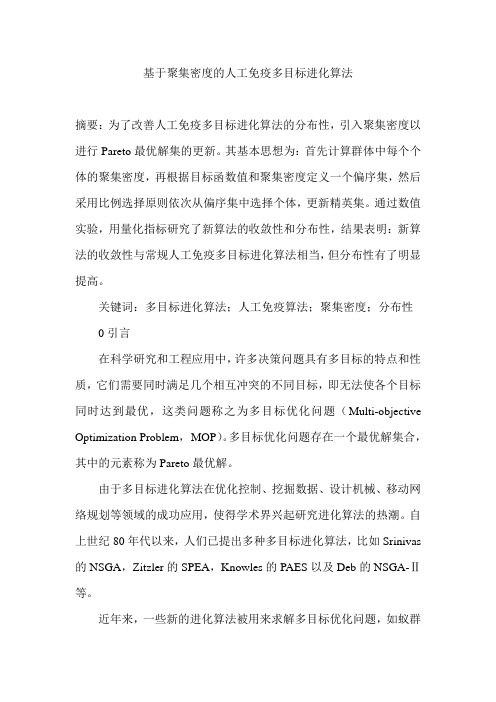
基于聚集密度的人工免疫多目标进化算法摘要:为了改善人工免疫多目标进化算法的分布性,引入聚集密度以进行Pareto最优解集的更新。
其基本思想为:首先计算群体中每个个体的聚集密度,再根据目标函数值和聚集密度定义一个偏序集,然后采用比例选择原则依次从偏序集中选择个体,更新精英集。
通过数值实验,用量化指标研究了新算法的收敛性和分布性,结果表明:新算法的收敛性与常规人工免疫多目标进化算法相当,但分布性有了明显提高。
关键词:多目标进化算法;人工免疫算法;聚集密度;分布性0引言在科学研究和工程应用中,许多决策问题具有多目标的特点和性质,它们需要同时满足几个相互冲突的不同目标,即无法使各个目标同时达到最优,这类问题称之为多目标优化问题(Multi-objective Optimization Problem,MOP)。
多目标优化问题存在一个最优解集合,其中的元素称为Pareto最优解。
由于多目标进化算法在优化控制、挖掘数据、设计机械、移动网络规划等领域的成功应用,使得学术界兴起研究进化算法的热潮。
自上世纪80年代以来,人们已提出多种多目标进化算法,比如Srinivas 的NSGA,Zitzler的SPEA,Knowles的PAES以及Deb的NSGA-Ⅱ等。
近年来,一些新的进化算法被用来求解多目标优化问题,如蚁群算法、粒子群算法、免疫算法、分布估计算法等。
上世纪90年代末,人工免疫算法开始兴起,其思想源于生物的免疫系统,它借鉴了免疫系统的功能、原理和模型并用于进行寻优搜索。
由于现在还不能充分认识免疫机理,所以有关免疫算法的研究基本集中在其它算法。
我们用免疫原理来改进并构成新的算法,比如免疫神经网络、免疫遗传算法等。
人工免疫系统算法的自身研究成果并不多,主要有基于克隆选择原理的克隆选择算法和基于阴性选择原理的阴性选择算法等。
Coello Coello等于2002年最早提出将人工免疫系统算法用于求解多目标优化问题,并陆续对其进行了改进;Luh等于2003年提出了多目标免疫算法MOIA;Jiao等于2005年提出免疫克隆多目标算法IDC-MA。
免疫进化算法
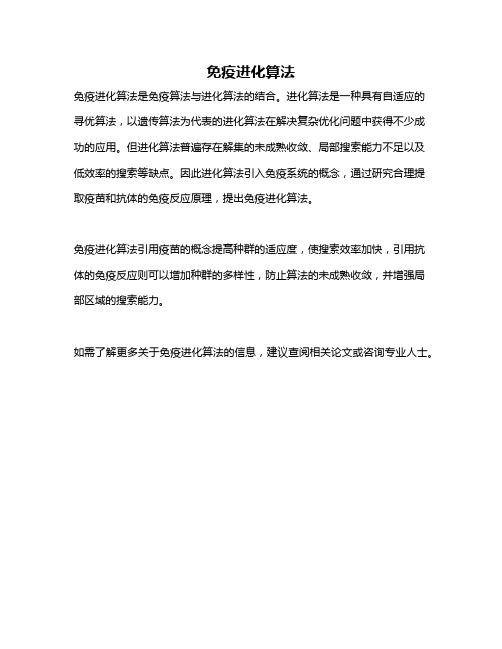
免疫进化算法
免疫进化算法是免疫算法与进化算法的结合。
进化算法是一种具有自适应的寻优算法,以遗传算法为代表的进化算法在解决复杂优化问题中获得不少成功的应用。
但进化算法普遍存在解集的未成熟收敛、局部搜索能力不足以及低效率的搜索等缺点。
因此进化算法引入免疫系统的概念,通过研究合理提取疫苗和抗体的免疫反应原理,提出免疫进化算法。
免疫进化算法引用疫苗的概念提高种群的适应度,使搜索效率加快,引用抗体的免疫反应则可以增加种群的多样性,防止算法的未成熟收敛,并增强局部区域的搜索能力。
如需了解更多关于免疫进化算法的信息,建议查阅相关论文或咨询专业人士。
免疫算法matlab -回复

免疫算法matlab -回复什么是免疫算法?免疫算法是一种受到人类免疫系统启发而创建的计算模型。
它模仿了生物免疫系统对抗外部侵入的能力,以解决复杂问题。
免疫算法主要包括免疫机制和进化策略,通过自适应搜索和学习过程来优化问题的求解。
在人类免疫系统中,免疫细胞通过识别和清除体内的外来物质(抗原)来维持身体的健康。
类似地,免疫算法中的个体(抗体)通过与问题的解进行匹配和选择来求解一个优化问题。
个体的适应度评估类似于抗体与抗原的抗原结合能力。
免疫算法的学习过程类似于人类免疫系统的记忆,通过记录历史信息并将其应用于问题的求解。
免疫算法中的个体表示为抗体,它们用于表示问题的解空间。
抗体的结构通常是一串二进制位,其中每一位表示解的某个特征。
免疫算法中最常用的两种表示方法是二元编码和浮点编码。
二元编码将解表示为一串二进制位,每个位的值为0或1。
浮点编码使用实数表示解的特征,通常将解空间划分为多个区间。
免疫算法中的免疫机制包括选择、变异和克隆。
选择是通过适应度评估来选择具有较高适应度的个体。
变异是通过改变个体的某些特征来引入新的解。
克隆是通过复制和修改个体来增加解空间的多样性。
这些免疫机制模仿了人类免疫系统中的免疫选择、免疫变异和免疫记忆的过程。
进化策略是免疫算法中的另一个重要组成部分。
进化策略通常包括遗传算子和进化策略控制参数。
遗传算子包括交叉和变异,通过改变个体的基因来产生新的解。
交叉是通过将两个个体的基因片段进行互换来产生新的解。
变异是通过修改个体的某些基因来引入新的解。
进化策略控制参数决定了进化过程中遗传算子的使用概率和变异的幅度。
免疫算法的求解过程可以概括为以下几个步骤。
首先,初始化抗体群体并计算每个抗体的适应度。
其次,使用免疫机制(选择、变异和克隆)生成新的抗体群体。
然后,计算新群体的适应度并选择具有较高适应度的个体。
最后,重复进行生成和选择的过程,直到满足停止准则。
免疫算法在许多领域中都得到了广泛的应用。
小生境进化免疫算法
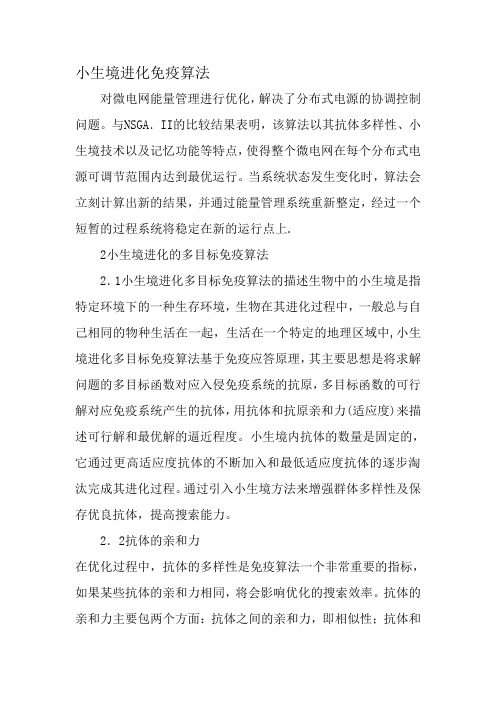
小生境进化免疫算法对微电网能量管理进行优化,解决了分布式电源的协调控制问题。
与NSGA.II的比较结果表明,该算法以其抗体多样性、小生境技术以及记忆功能等特点,使得整个微电网在每个分布式电源可调节范围内达到最优运行。
当系统状态发生变化时,算法会立刻计算出新的结果,并通过能量管理系统重新整定,经过一个短暂的过程系统将稳定在新的运行点上.2小生境进化的多目标免疫算法2.1小生境进化多目标免疫算法的描述生物中的小生境是指特定环境下的一种生存环境,生物在其进化过程中,一般总与自己相同的物种生活在一起,生活在一个特定的地理区域中,小生境进化多目标免疫算法基于免疫应答原理,其主要思想是将求解问题的多目标函数对应入侵免疫系统的抗原,多目标函数的可行解对应免疫系统产生的抗体,用抗体和抗原亲和力(适应度)来描述可行解和最优解的逼近程度。
小生境内抗体的数量是固定的,它通过更高适应度抗体的不断加入和最低适应度抗体的逐步淘汰完成其进化过程。
通过引入小生境方法来增强群体多样性及保存优良抗体,提高搜索能力。
2.2抗体的亲和力在优化过程中,抗体的多样性是免疫算法一个非常重要的指标,如果某些抗体的亲和力相同,将会影响优化的搜索效率。
抗体的亲和力主要包两个方面:抗体之间的亲和力,即相似性;抗体和抗原的亲和力,即适应度。
抗体的相似性可以通过抗体之问的欧氏距离来描述,记第i个抗体为置,第,个抗体为X,,则抗体的相似性可以通过抗体之问的欧氏距离来描述,记第i个抗体为置Xi,第j个抗体为Xj,则llXi-Xj11为Xi,与Xj之间的欧氏距离。
抗体对抗原的适应度可由式(6)目标函数的倒数来表示,抗体的目标函数值越小表明它越接近最优解,适应度就越高。
对于距离小于某一定值L的抗体,比较两者适应度A(Xi)和A(Xj)的大小,如果A(Xi)>A(Xj),则对A(Xj)施加一个较强的惩罚函数,使其适应度变得极小,在以后的进化中Xj,会以极大的概率被淘汰。
第7章免疫算法

第7章免疫算法免疫算法(Immune Algorithm)是一种模拟人体免疫系统中免疫响应与进化过程的智能优化算法。
它作为一种新颖的和优化算法,可以用于求解许多实际问题,如工程设计、数据挖掘、图像处理等。
免疫算法的研究主要依据人体免疫系统的原理和特性,将免疫系统中的关键概念和过程转化为算法运算。
本章将介绍免疫算法的基本原理、算法流程和应用领域。
免疫系统是人体在抵抗病毒、细菌等有害入侵物质的过程中发挥重要作用的生理系统。
它具有识别和消灭外来入侵物质的能力,并具有自我保护和自主进化的特点。
免疫算法基于人体免疫系统的这些特性,通过模拟免疫细胞的选择、克隆和进化过程,实现对复杂优化问题的和解决。
免疫算法的基本原理包括:群体多样性、记忆机制和进化演化。
群体多样性指的是免疫系统中存在多种不同类型的免疫细胞,以应对不同种类的入侵物质。
免疫算法通过模拟不同类型的抗体和克隆选择过程,保持算法中个体的多样性,增加优化的广度和深度。
记忆机制指的是免疫细胞对入侵物质的记忆,以便在下次出现相似入侵物质时更加迅速和有效地进行响应。
免疫算法通过引入记忆机制来避免过程中重复生成已经出现的个体。
进化演化是免疫系统中个体的选择、复制和演化过程,通过自我适应和自我进化来提高整体的适应性和生存能力。
免疫算法通过模拟这些进化过程,不断更新并优化空间中的个体。
免疫算法的具体流程可以分为初始化阶段、选择阶段、演化阶段和终止条件判断阶段。
在初始化阶段,算法根据问题的特点和约束条件,生成一定数量的初始个体。
在选择阶段,根据个体适应度评价,选择出一定数量的个体作为新的种群。
在演化阶段,通过克隆、突变等操作,生成新的个体,并将它们加入到种群中。
在终止条件判断阶段,根据预设的终止条件判断是否结束算法的运行。
免疫算法的应用领域非常广泛。
在工程设计领域,免疫算法可以用于寻找最优的结构参数、优化控制策略等问题。
在数据挖掘领域,免疫算法可以用于分类、聚类和关联规则挖掘等问题。
免疫遗传算法实例
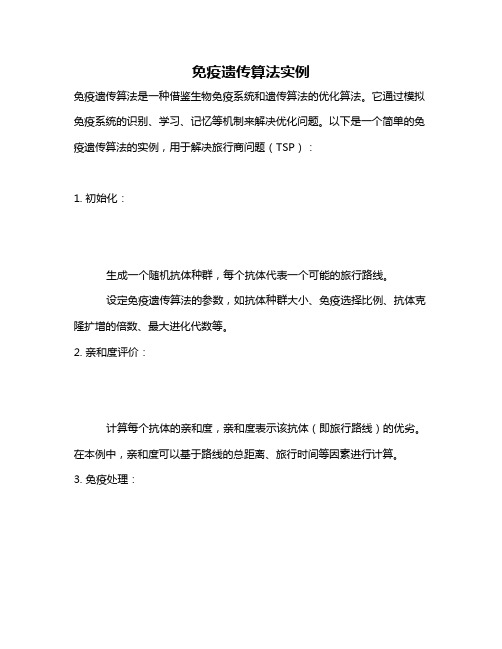
免疫遗传算法实例
免疫遗传算法是一种借鉴生物免疫系统和遗传算法的优化算法。
它通过模拟免疫系统的识别、学习、记忆等机制来解决优化问题。
以下是一个简单的免疫遗传算法的实例,用于解决旅行商问题(TSP):
1. 初始化:
生成一个随机抗体种群,每个抗体代表一个可能的旅行路线。
设定免疫遗传算法的参数,如抗体种群大小、免疫选择比例、抗体克隆扩增的倍数、最大进化代数等。
2. 亲和度评价:
计算每个抗体的亲和度,亲和度表示该抗体(即旅行路线)的优劣。
在本例中,亲和度可以基于路线的总距离、旅行时间等因素进行计算。
3. 免疫处理:
免疫选择:选择亲和度靠前的部分抗体进行免疫处理,一般取前
NP/2,使其活化。
克隆:对活化的抗体进行克隆复制,产生更多的相似抗体。
变异:对克隆副本进行变异操作,保留被克隆抗体,主要针对亲和度。
克隆抑制:对变异结果进行筛选,保留亲和度高的变异结果。
4. 种群刷新:
随机生成部分新的抗体种群,与免疫处理的抗体合并,形成新一代抗体。
5. 重复步骤2-4直到达到最大进化代数或满足终止条件:
最大进化代数是为了避免算法陷入局部最优解,当达到最大进化代数时停止迭代。
6. 输出最优解:
最终剩下的高亲和度抗体即为最优解,即最优的旅行路线。
以上是一个简化的免疫遗传算法实例,实际应用中可能还需要考虑其他因素和步骤,如基于欧式距离或海明距离计算抗体之间的距离等。
此外,针对不同的问题和数据集,还需要调整算法参数和步骤以获得更好的优化效果。
一个与Powell搜索相结合的混合免疫进化算法

求解无约束最优化问题 的一个 高效的算法。 关键词 :P w l 索法;免疫进化算法 ;无约束最优化 o el 搜 中图分类号 :T 1 P8 文献标识码 :A 文章编号 :17 - 8 0( 0 0) 2 0 2 一 4 62 97 2 1 0- 11 o
A b i wel e r h An m m u eEv l to a y Al o ih Hy rd Po l S a c d I n o u i n r g r t m Fo c n t a n d Op i i a i n rUn o s r i e tm z to
免疫遗传算法
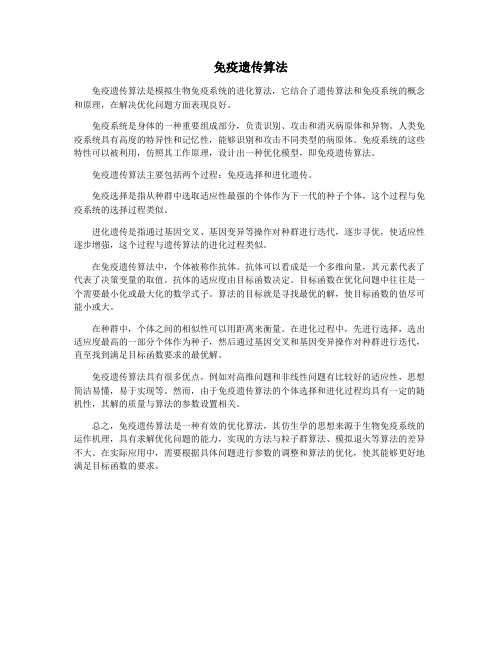
免疫遗传算法免疫遗传算法是模拟生物免疫系统的进化算法,它结合了遗传算法和免疫系统的概念和原理,在解决优化问题方面表现良好。
免疫系统是身体的一种重要组成部分,负责识别、攻击和消灭病原体和异物。
人类免疫系统具有高度的特异性和记忆性,能够识别和攻击不同类型的病原体。
免疫系统的这些特性可以被利用,仿照其工作原理,设计出一种优化模型,即免疫遗传算法。
免疫遗传算法主要包括两个过程:免疫选择和进化遗传。
免疫选择是指从种群中选取适应性最强的个体作为下一代的种子个体,这个过程与免疫系统的选择过程类似。
进化遗传是指通过基因交叉、基因变异等操作对种群进行迭代,逐步寻优,使适应性逐步增强,这个过程与遗传算法的进化过程类似。
在免疫遗传算法中,个体被称作抗体。
抗体可以看成是一个多维向量,其元素代表了代表了决策变量的取值。
抗体的适应度由目标函数决定。
目标函数在优化问题中往往是一个需要最小化或最大化的数学式子。
算法的目标就是寻找最优的解,使目标函数的值尽可能小或大。
在种群中,个体之间的相似性可以用距离来衡量。
在进化过程中,先进行选择,选出适应度最高的一部分个体作为种子,然后通过基因交叉和基因变异操作对种群进行迭代,直至找到满足目标函数要求的最优解。
免疫遗传算法具有很多优点,例如对高维问题和非线性问题有比较好的适应性,思想简洁易懂,易于实现等。
然而,由于免疫遗传算法的个体选择和进化过程均具有一定的随机性,其解的质量与算法的参数设置相关。
总之,免疫遗传算法是一种有效的优化算法,其仿生学的思想来源于生物免疫系统的运作机理,具有求解优化问题的能力,实现的方法与粒子群算法、模拟退火等算法的差异不大。
在实际应用中,需要根据具体问题进行参数的调整和算法的优化,使其能够更好地满足目标函数的要求。
一种基于混沌的自适应免疫进化算法

se5对群 体 A tp 中个 体进行 突变操 作得 到群 体 A4群体 A2中未 突 变 的个 体 和 群 体 A4组 成 群 体 ,
A 5;
优 化计算 。本 文参 考 文献 [ , ]提 出 了一 种基 于混 45 ,
沌的 自 适应免疫进 化算法 ( IA 。和文献 [ ] AE ) 5 相
解对 问题 的满 足程 度 , 目标 值 或 其变 换 视 为 亲 和 将 度 。抗体 的编码采 用 实数编 码 。 算法 的主要步 骤 为 sp t l随机产 生 含有 N 个个 体 的初始 群体 A ; e
沌优 化方 法在搜 索 空 间小时 效果 显 著 , 当搜 索 空 但
间大 时则不 能令 人 满 意 [ 近年 来 , 工 免 疫 算 法 。 人
及其应 用 已成 为崭新 的研 究 领域并 受 到计算智 能 学 者 的广 泛关 注 , 继 神 经 网络 及 进 化计 算 之 后 的 又 是
一
sp t 2计算群体 A 中的个体亲和度 ; e sp t 3对 群体 A 执 行 选择 操 作 , 出 个 亲和 e 选
度高 的个 体组成 群 体 A, ; s l 对 群体 A 中个 体进行 扩 展操作 得到 含有 tM e N 个个 体 的群 体 A2群 体 A2中亲 和度 低 的N 一 ,
6 =
f a- mx
() 5
式中, 为变换后的亲和度值 , 为原亲和度值 , 厂 . 厂 口, b为系数 , 为群体 A1 体平均 亲和度值 , 为 个
其 中最大亲 和度值 , k为常数 , 范围一般 为 12~ 取值 .
2 算法的详细说明
算法 的改进 部分 主要 为初 始群 体 的产 生 、 和 亲
免疫算法

ayv , w
1 = 1 + E ( 2)
其中E(2)表示v和w之间的信息熵 (4)记忆细胞分化:与抗原有最大亲和力的抗体加入记忆 细胞。由于记忆细胞数目有限,新产生的抗体将会代替 记忆细胞中和它具有最大亲和力者。
二、免疫算法的基本模型及算法
• 3.免疫算法的基本步骤
(5)抗体促进和抑制:高亲和力抗体受到促进,高密度抗 体受到抑制。通常通过计算抗体存活的期望值来实施。 可有效的防止早熟。 qk表示和抗体k具有较大亲和力的抗体数目。
• 2.二进制模型
主要涉及识别和刺激两个内容
刺激: 以两个抗体相互识别为例,抗体A的抗原决定 簇能识别抗体B的抗原决定基,首相导致抗体A以 固定的概率大量繁殖,同时之间清除抗体B。
二、免疫算法的基本模型及算法
• 2.二进制模型
主要涉及识别和刺激两个内容
刺激: 抗体浓度变化方程如下: 其中抗体浓度为x,抗原浓度为y。
axv ev = cv
qk cv = − N
二、免疫算法的基本模型及算法
• 3.免疫算法的基本步骤
(6)抗体产生:对未知抗原的响应,产生新淋巴细胞。 根据不同抗体和抗原亲和力的高低,使用赌轮选择 的方法,选择两个抗体。然后把这两个抗体按一定变异 概率做变异,之后再交叉,得到新的抗体。如此重复(6) 直到产生N个新抗体。
(7)结束条件 如果求出的最优解满足一定的结束条件,则结束算 法。
二、免疫算法的基本模型及算法
• 4.免疫算法的基本流程
抗原识别
初始抗体生成
N
亲和力计算 记忆细胞分化 抗体促进和抑制
满足终止条件?群体更新Y结束三、常用的免疫算法
三、常用的免疫算法
• 一般的免疫算法可分为三种情况:
不同映射的混沌免疫进化算法性能分析
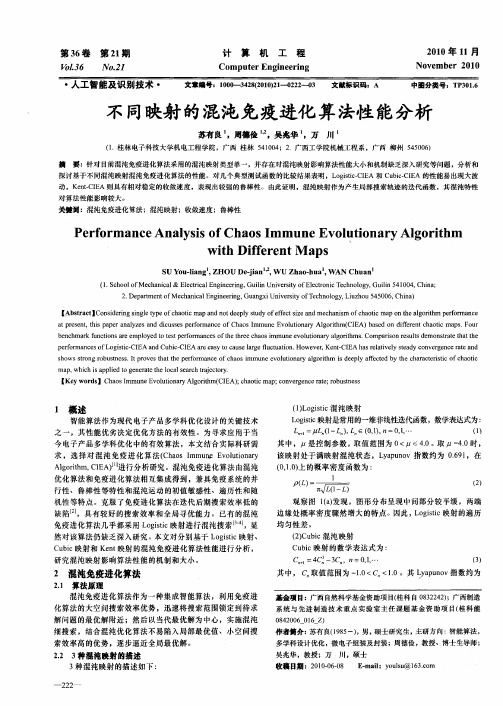
中圈分类号: P0. T31 6
不 同映射 的混沌 免 疫进化 算 法性 能 分析
苏有良 ,周德俭 , 兆华 吴 ,万 川
(.桂林 电子科技大学机 电工程学院,广西 桂林 5 10 1 4 04;2 广西工学院机械工程系,广西 柳州 5 5 0 ) . 4 0 6
摘
要: 针对 目前混沌免疫进化算法采用的混沌映射类型单一 ,并存在对混沌映射影响算法性能大小和机制缺乏深入研究等 问题 , 分析和
S o —a g, HOUDe in W U Z a. u WA h a UY ul n Z i -a , h oh a, N C u n j
( . c o l f c a ia & E eti l n ie r g G i nU ies yo E e t n c e h oo y Gul 4 0 4 C ia 1 S h o Me h nc l o l r a gn e i , u l n v ri f l r i T c n lg , in5 1 0 , hn ; c c E n i t co i
第3
计
算
机
工 程
21 0 0年 1 1月
No e b r 20 0 v m e 1
No 2 .l
Co pu e gi e i g m t rEn ne r n
人工 智能及 识别技 术 ・
文章 编号: o _48 0o 1_2 - 文献 l0 32( 1)—o 2 0 2 2 2— 3 标识码: A
对算法性能 影响较大 。
关健诃:混沌免疫进化算法 ; 混沌 映射 ;收敛速 度;鲁棒性
Pe f r a eAna y i fCha sI m uneEv l to r g rt r o m nc l sso o m o u i na yAl o ihm
- 1、下载文档前请自行甄别文档内容的完整性,平台不提供额外的编辑、内容补充、找答案等附加服务。
- 2、"仅部分预览"的文档,不可在线预览部分如存在完整性等问题,可反馈申请退款(可完整预览的文档不适用该条件!)。
- 3、如文档侵犯您的权益,请联系客服反馈,我们会尽快为您处理(人工客服工作时间:9:00-18:30)。
Illustration, Robin Hotchkiss
XIDIAN
UNIVERSITY
KEY LAB FOR RADAR SIGNAL PROCESSING
How our bodies fight disease?
Killer T cells destroy germs
Alerted by helper T cells, killer T cells multiply and destroy the invading germs. Working together, our white blood cells can usually destroy invading germs.
Photograph© UPI/Corbis-Bettmann
XIDIAN
UNIVERSITY
KEY LAB FOR RADAR SIGNAL PROCESSING
What is a virus?
Viruses are a simple form of life a few genes wrapped in a protective shell. These genes are the instructions for making new viruses. Outside a cell, a virus can't reproduce itself; but once a virus invades a living cell, it turns that cell into a virus factory. In time, thousands of new viruses burst out and go on to invade other cells.
Illustration, Robin Hotchkiss
XIDIAN
UNIVERSITY
KEY LAB FOR RADAR SIGNAL PROCESSING
How our bodies fight disease?
Macrophages identify germs
When a germ invades our bodies, macrophages gobble up the germ and display its surface shape, or antigen, for other immune cells to see.
White blood cells defend against germs
The immune system is made up of many different kinds of white blood cells. White blood cells work together to protect us against disease-causing germs.
Immune Evolutionary Algorithms
Dr. Lei WANG
XIDIAN UNIVERSITY KEY LAB FOR RADAR SIGNAL PROSESSING
2.76B Chemin du Musee 3 CH-1700 Fribourg, Switzerland Tel: ++41 26 300 8473 Fax: ++41 26 300 9731 E-mail: wanglei_2008@
Illustration, Robin Hotchkiss
XIDIR RADAR SIGNAL PROCESSING
How our bodies fight disease?
Helper T cells direct the defense
Helper T cells spot the foreign antigen on the macrophage and begin to multiply. They alert other white blood cells and direct the body's defense.
Illustration, Robin Hotchkiss
XIDIAN
UNIVERSITY
KEY LAB FOR RADAR SIGNAL PROCESSING
Fundamentals of the immune system
The immune system is the name of a collection of molecules, cells, and organs whose complex interaction form an efficient system that is usually able to protect an individual from both outside invaders and its own altered internal cells which lead to disease. The immune system is comprised of the lymphoid tissues and organs of the body. The immune system is into two components, non- divided specific, also referred to as innate or non-adaptive immunity, and specific which is also known as acquired or adaptive immunity.
XIDIAN
UNIVERSITY
KEY LAB FOR RADAR SIGNAL PROCESSING
Practice of vaccines
The practice of vaccination against disease began in 1796 by Edward Jenner, who used the pus of blisters from cowpox to vaccinate people against smallpox. Vaccination is perhaps viewed as the strongest preventive measure against disease in modern health care, and its practice and protocol has been improved in recent years by a growing number of doctors and scientists.
Illustration, Robin Hotchkiss
XIDIAN
UNIVERSITY
KEY LAB FOR RADAR SIGNAL PROCESSING
How our bodies fight disease?
B cells make antibodies
B cells start to make chemicals called antibodies. Antibodies lock onto foreign antigens making it easier for other immune cells to destroy them.
Viruses, bacteria and other germs are all around us.
Most of the time, a healthy immune system keeps us well.
Photograph© A.J. Olsen, The Scripps Research Institute, 1987
XIDIAN
UNIVERSITY
KEY LAB FOR RADAR SIGNAL PROCESSING
Inspirations from immune system
The natural immune system is a complex adaptive system, which can be regarded as a good reference for our researches, for example, adaptive computation, computer simulation, modeling, nonlinear dynamical analysis, etc. Vaccination is the main method people use to improve our immune capability and many good results have been received, and therefore, it is another reference for our designing of algorithms or system structure.
Part one:
Natural immune systems
Important sources of inspiration to our mind.
XIDIAN
UNIVERSITY
KEY LAB FOR RADAR SIGNAL PROCESSING
Safe due to our immune system
Photograph© Boehringer Ingelheim International GmbH
Photograph© Mushin Ozel, Robert Koch-Institute
XIDIAN
UNIVERSITY
KEY LAB FOR RADAR SIGNAL PROCESSING
How our bodies fight disease?
XIDIAN
